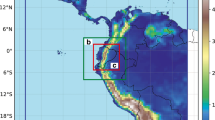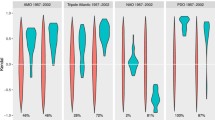Abstract
Previous studies have shown that there are several indices of global-scale temperature variations, in addition to global-mean surface air temperature, that are useful for distinguishing natural internal climate variations from anthropogenic climate change. Appropriately defined, such indices have the ability to capture spatio-temporal information in a similar manner to optimal fingerprints of climate change. These indices include the contrast between the average temperatures over land and over oceans, the Northern Hemisphere meridional temperature gradient, the temperature contrast between the Northern and Southern Hemisphere and the magnitude of the annual cycle of average temperatures over land. They contain information independent of the global-mean temperature for internal climate variations at decadal time scales and represent different aspects of the climate system, yet they show common responses to anthropogenic climate change. In addition, the ratio of average temperature changes over land to those over the oceans should be nearly constant for transient climate change. Hence, supplementing analysis of global-mean surface temperature with analyses of these indices can strengthen results of attribution studies of causes of observed climate variations. In this study, we extend the previous work by including the last 10 years of observational data and the CMIP3 climate model simulations analysed for the IPCC AR4. We show that observed changes in these indices over the last 10 years provide increased evidence of an anthropogenic influence on climate. We also show the usefulness of these indices for evaluating the performance of climate models in simulating large-scale variability of surface temperature.





Similar content being viewed by others
References
Barnett T, Zwiers F, Hegerl G, Allen M, Crowley T, Gillett N, Hasselmann K, Jones P, Santer B, Schnur R, Scott P, Taylor K, Tett S (2005) Detecting and attributing external influences on the climate system: a review of recent advances. J Clim 18(9):1291–1314. doi:10.1175/JCLI3329.1
Braganza K, Karoly DJ, Hirst AC, Mann ME, Stott PA, Stouffer RJ, Tett SFB (2003) Simple indices of global climate variability and change: part I: variability and correlation structure. Clim Dyn 20:491–502. doi:10.1007/s00382-002-0286-0
Braganza K, Karoly DJ, Hirst AC, Stott PA, Stouffer RJ, Tett SFB (2004) Simple indices of global climate variability and change part II: attribution of climate change during the twentieth century. Clim Dyn 22:823–838. doi:10.1007/s00382-004-0413-1
Brohan P, Kennedy JJ, Harris I, TSF B, Jones PD (2006) Uncertainty estimates in regional, global observed temperature changes: a new data set from 1850. J Geophys Res 111:D12106. doi:10.1029/2005JD006548
Christensen JH, Hewitson B, Busuioc A, Chen A, Gao X, Held I, Jones R, Kolli RK, Kwon W-T, Laprise R, Magaña Rueda V, Mearns L, Menéndez CG, Räisänen J, Rinke A, Sarr A, Whetton P (2007) Climate change 2007: the physical science basis. Contribution of working group I to the fourth assessment report of the intergovernmental panel on climate change. Regional climate projections, vol 11. Cambridge University Press, Cambridge
Collins WD, Bitz CM, Blackmon ML, Bonan GB, Bretherton CS, Carton JA, Chang P, Doney SC, Hack JJ, Henderson TB, Kiehl JT, Large WG, McKenna DS, Santer BD, Smith RD (2006) The community climate system model version 3 (CCSM3). J Clim 19(11):2122–2143. doi:2110.1175/JCLI3761.2121
Dalan F, Stone PH, Sokolov AP (2005) Sensitivity of the ocean’s climate to diapycnal diffusivity in an EMIC. Part II: global warming scenario. J Clim 18:2482–2496
Domingues CM, Church JA, White NJ, Gleckler PJ, Wijffels SE, Barker PM, Dunn JR (2008) Improved estimates of upper-ocean warming and multi-decadal sea-level rise. Nature 453:1090–1094. doi:10.1038/nature07080
Fawcett R (2007) Has the world cooled since 1998? Bull Aus Meteorol Oceanogr Soc 20:141–148
Gitelman A, Risbey J, Kass R, Rosen R (1997) Trends in the surface meridional temperature gradient. Geophys Res Lett 24:1243–1246
Gitelman A, Risbey J, Kass R, Rosen R (1999) Sensitivity of a meridional temperature gradient index to latitudinal domain. J Geophys Res 104:16, 709–717
Gordon HB, Rotstayn LD, McGregor JL, Dix MR, Kowalczyk EA, O’Farrell SP, Waterman LJ, Hirst AC, Wilson SG, Collier MA, Watterson IG, Elliott TI (2002) The CSIRO Mk3 climate system model. Atmos Res 60(60)
Hansen J, Ruedy R, Sato M, Imhoff M, Lawrence W, Easterling D, Peterson T, Karl T (2001) A closer look at United States and global surface temperature change. J Geophys Res 106(D20):23947–23963
Hansen J, Ruedy R, Sato M, Lo K (2010) Global surface temperature change. Rev Geophys 48:RG4004. doi:10.1029/2010RG000345
Hegerl GC, Karl TR, Allen M, Bindoff NL, Gillett N, Karoly D, Zhang X, Zwiers F (2006) Climate change detection and attribution: beyond mean temperature signals. J Clim 19(20):5058–5077. doi:10.1175/JCLI3900.1
Jain S, Lall U, Mann ME (1999) Seasonality and interannual variations of northern hemisphere temperature: equator-to-pole gradient and ocean–land contrast. J Clim 12(4):1086–1100
Jones PD, Wigley TML (2010) Estimation of global temperature trends: what’s important and what isn’t? Clim Chang 100:59–69. doi:10.1007/s10584-010-9836-3
Joshi MM, Gregory JM (2008) Dependence of the land-sea contrast in surface climate response on the nature of the forcing. Geophys Res Lett 35(L24802). doi:10.1029/2008GL036234
Joshi MM, Gregory JM, Webb MJ, Sexton DMH, Johns TC (2008) Mechanisms for the land/sea warming contrast exhibited by simulations of climate change. Clim Dyn 30(5):455–465
K-1 Model Developers (2004) K-1 coupled model (MIROC) description. In: Hasumi M, Emori S (eds) K-1 technical report 1. Center for Climate System Research, University of Tokyo, Tokyo
Karoly DJ, Braganza K (2001) Identifying global climate change using simple indices. Geophys Res Lett 28(11):2205–2208
Levitus S, Antonov J, Boyer T (2005) Warming of the world ocean, 1955–2003. Geophys Res Lett 32:L02604. doi:10.1029/2004GL021592
Levitus S, Antonov JI, Boyer TP, Locarnini RA, Garcia HE, Mishonov AV (2009) Global ocean heat content 1955–2008 in light of recently revealed instrumentation problems. Geophys Res Lett 36:L07608. doi:10.1029/2008GL037155
Manabe S, Stouffer RJ, Spelman MJ, Bryan K (1991) Transient responses of a coupled ocean-atmosphere model to gradual changes of atmospheric CO2. Part I: annual mean response. J Clim 4:785–818
McFarlane NA, Boer GJ, Blanchet J-P, Lazare M (1992) The Canadian climate centre second-generation general circulation model and its equilibrium climate. J Clim 5:1013–1044
Meehl GA, Covey C, Delworth T, Latif M, McAvaney B, Mitchell JFB, Stouffer RJ, Taylor KE (2007) The WCRP CMIP3 multi-model dataset: a new era in climate change research. Bull Am Meteorol Soc 88:1383–1394
Roeckner E, Arpe K, Bengtsson L, Christoph M, Claussen M, Dümenil L, Esch M, Giorgetta M, Schlese U, Schulzweida U (1996) The atmospheric general circulation model ECHAM-4: model description and simulation of present-day climates, vol 218. Reports of the Max-Planck-Institute, Hamburg
Roeckner E, Bäuml G, Bonaventura L, Brokopf R, Esch M, Giorgetta M, Hagemann S, Kirchner I, Kornblueh L, Manzini E, Rhodin A, Schlese U, Schulzweida U, Tompkins A (2003) The atmospheric general circulation model ECHAM5. Part I: model description, vol 349. Max Planck Institute for Meteorology, Germany
Santer BD, Taylor KE, Wigley TML, Johns TC, Jones PD, Karoly DJ, Mitchell JFB, Oort AH, Penner JE, Ramaswamy V, Schwarzkopf MD, Stouffer RJ, Tett S (1996) A search for human influences on the thermal structure of the atmosphere. Nature 382:39–46. doi:10.1038/382039a0
Schmittner A, Urban NM, Keller K, Matthews D (2009) Using tracer observations to reduce the uncertainty of ocean diapycnal mixing and climate–carbon cycle projections. Glob Biogeochem Cycles 23:GB4009. doi:10.1029/2008GB003421
Scinocca JF, McFarlane NA, Lazare M, Li J, Plummer D (2008) The CCCma third generation AGCM and its extension into the middle atmosphere. Atmos Chem Phys 8:7055–7074
Smith TM, Reynolds RW (2005) A global merged land–air–sea surface temperature reconstruction based on historical observations (1880–1997). J Clim 18:2021–2036
Smith TM, Reynolds RW, Peterson TC, Lawrimore J (2008) Improvements to NOAA’s historical merged land–ocean surface temperature analysis (1880–2006). J Clim 21:2283–2296
Solomon S, Rosenlof KH, Portmann RW, Daniel JS, Davis SM, Sanford TJ, Plattner G-K (2010) Contributions of stratospheric water vapour to decadal changes in the rate of global warming. Science 327:1219–1223. doi:10.1126/science.1182488
Stott PA, Mitchell JFB, Allen MR, Delworth TL, Gregory JM, Meehl GA, Santer BD (2006) Observational constraints on past attributable warming and predictions of future global warming. J Clim 19:3055–3069
Sutton RT, Dong B-W, Gregory JM (2007) Land/sea warming ratio in response to climate change: IPCC AR4 model results and comparison with observations. Geophys Res Lett 34:L02701. doi:10.1029/2006GL028164
Thompson DWJ, Wallace JM, Jones PD, Kennedy JJ (2009) Identifying signatures of natural climate variability in time series of global-mean surface temperature: methodology and insights. J Clim 22:6120–6141
Trenberth KE, Jones PD, Ambenje P, Bojariu R, Easterling D, Klein Tank A, Parker D, Rahimzadeh F, Renwick JA, Rusticucci M, Soden B, Zhai P (2007) Observations: surface and atmospheric climate change. In: Solomon S, Qin D, Manning M, Chen Z, Marquis M, Averyt KB, Tignor M, Miller HL (eds) Climate change 2007: the physical science basis. Contribution of working group I to the fourth assessment report of the intergovernmental panel on climate change. Cambridge University Press, Cambridge
Urban NM, Keller K (2009) Complementary observational constraints on climate sensitivity. Geophys Res Lett 36:L04708. doi:10.1029/2008GL036457
Washington WM, Weatherly JW, Meehl GA, Semtner AJ Jr, Bettge TW, Craig AP, Strand WG Jr, Arblaster J, Wayland VB, James R, Zhang Y (2000) Parallel climate model (PCM) control and transient simulations. Clim Dyn 16:755–774
Yukimoto S, Noda A (2002) Improvements of the meteorological research institute global ocean atmosphere coupled GCM (MRI-CGCM2) and its climate sensitivity. CGER’s supercomputer activity report, vol 10. NIES, Japan
Yukimoto S, Noda A, Kitoh A, Sugi M, Kitamura Y, Hosaka M, Shibata K, Maeda S, Uchiyama T (2001) The new meteorological research institute coupled GCM (MRI-CGCM2): model climate and variability. Pap Meteorol Geophys 51(2):47–88
Acknowledgments
We acknowledge the modelling groups, the Program for Climate Model Diagnosis and Intercomparison (PCMDI) and the WCRP’s Working Group on Coupled Modelling (WGCM) for their roles in making available the WCRP CMIP3 multi-model dataset. This research was supported by an Australian Research Council Federation Fellowship (project FF0668679).
Author information
Authors and Affiliations
Corresponding author
Rights and permissions
About this article
Cite this article
Drost, F., Karoly, D. & Braganza, K. Communicating global climate change using simple indices: an update. Clim Dyn 39, 989–999 (2012). https://doi.org/10.1007/s00382-011-1227-6
Received:
Accepted:
Published:
Issue Date:
DOI: https://doi.org/10.1007/s00382-011-1227-6




